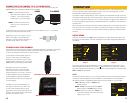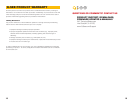
14 15
DAY NIGHT - Sets the threshold level for when the camera should switch to night mode.
NIGHT DAY - Sets the threshold level for when the camera should switch to day mode.
The value range for both thresholds is 0-255.
AREA SEL - This indicates which of the four motion detection areas you are working on.
TOP, BOTTOM, LEFT, RIGHT - These settings are used to define the size of the motion
detection area.
PRIVACY
This allows you to set up areas within the camera’s view that will be blocked from observation.
This may be the location of a combination lock, keypad or other area that requires privacy.
Like Motion Detection above, use of this feature is not recommended when the camera is
connected to a security DVR as it will create artifacts on the video recording which cannot be
removed.
MOTION DETECTION
Unlike most security cameras, your camera is capable of detecting motion by itself. If you are
connecting your camera to a Q-See security DVR, you will not need to enable this feature as
the DVR itself has motion detection capabilities. Enabling motion detection on the camera
while connected to a security DVR can produce adverse results by obscuring the recorded
video or generating artifacts which the DVR will interpret as motion causing it to record un-
necessarily.
MOTION DETECT
DETECT SENSE 111
BLOCK DISP OFF
MONITOR AREA OFF
AREA SEL 1/4
TOP 000
BOTTOM 000
LEFT 000
RIGHT 000
RETURN
PRIVACY
AREA SEL 1/4
TOP 000
BOTTOM 000
LEFT 000
RIGHT 000
COLOR 1
TRANSP 1.00
MOSAIC OFF
RETURN
DETECT SENSE - The camera’s level of sen-
sitivity to motion. The value range is 0-127.
BLOCK DISP - If this is turned on, the cam-
era will generate pixelated blocks to highlight
motion within its view. It should be noted that
if you have this enabled while the camera is
connected to a security DVR, the DVR will
record the blocks as part of the video and
these cannot be removed from the recording.
MONITOR AREA - When enabled, you may
select up to four areas where motion will be
detected.
AREA SEL - This indicates which of the eight
motion detection areas you are working on.
TOP, BOTTOM, LEFT, RIGHT - As in Motion
Detection, these settings are used to define
the size of the motion detection area.
COLOR - The zone may be set to one of
eight colors; red, green, blue, light green, light
blue, light red, white and black.
TRANSPARENCY - This sets the opacity of
the privacy block.
MOSAIC - Events occurring in the privacy
area are pixelated.
DAY/NIGHT MODE
This allows you to set the camera to switch automatically from day to night mode (the default)
or to permanently set it to Color or B/W operation. Please note that even when the camera is
set to Color mode, it will switch to black and white night vision when there is no longer enough
ambient light to support color video.
DAY/NIGHT
BURST ON
DELAY CNT 003
DAY NIGHT 003
NIGHT DAY 003
RETURN
You can adjust the automatic settings.
BURST - This is a signal sent out by the
camera even when no color information
is available. Some DVRs or security video
capture cards may require this to recognize
the camera. Q-See security DVRs do not
need a burst signal and it may be turned off.
DELAY CNT - The time interval delay before
switching from day to night mode.
NR
NR MODE Y/C
Y 004
C 004
RETURN
NR (NOISE REDUCTION)
In low-light situations, there may be an
increase in “noise” (graininess or random
speckles in the video). Noise reduction can
be turned off or set to reduce noise in the
black and white (Y) and/or color (C) portions
of the signal. The value ranges for both the
Y and C filters is 0-15. The higher the value,
the more noise is reduced, but this can
reduce image sharpness.
IMPORTANT! The DAY NIGHT and NIGHT DAY operations should be
tested during installation. Block the lens for a few seconds to force a switch
to night mode. Once the lens is unblocked, the camera should switch back to
day mode in less than 10 seconds. If it does not, slightly increase the threshold in the NIGHT
DAY setting. A dimly lit area or a very low iris setting may also prevent a return to day mode.













